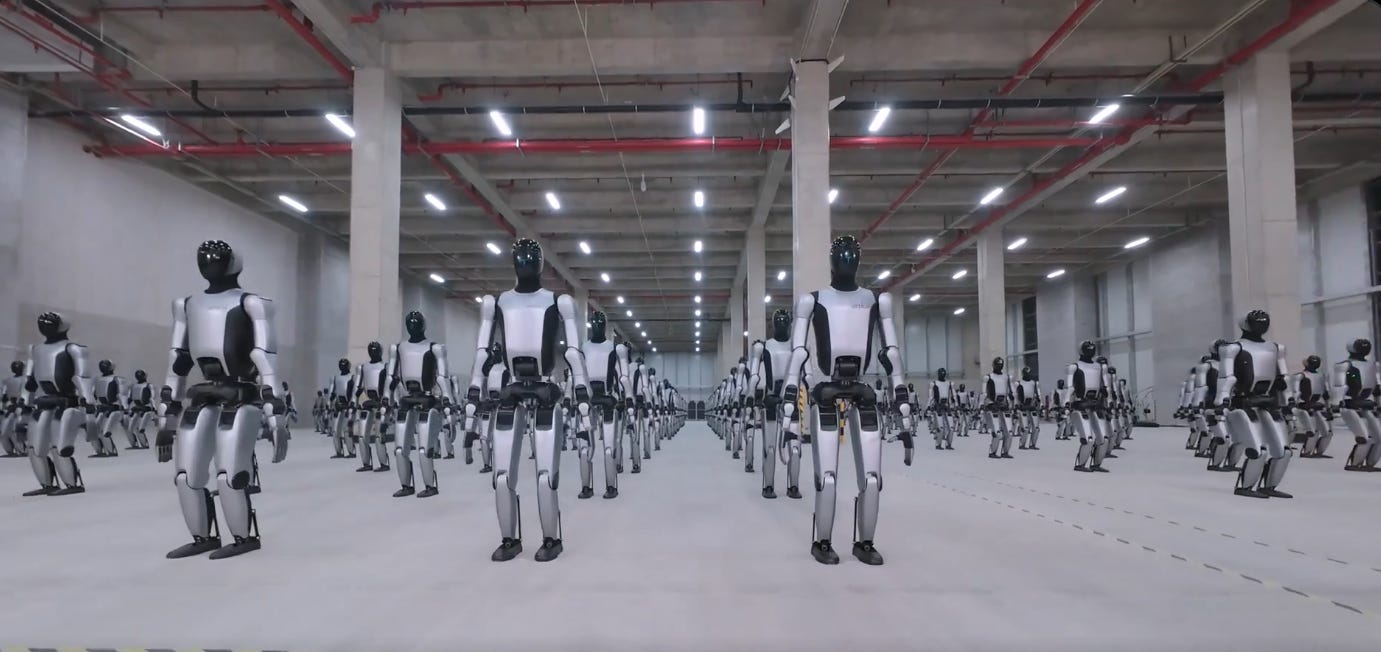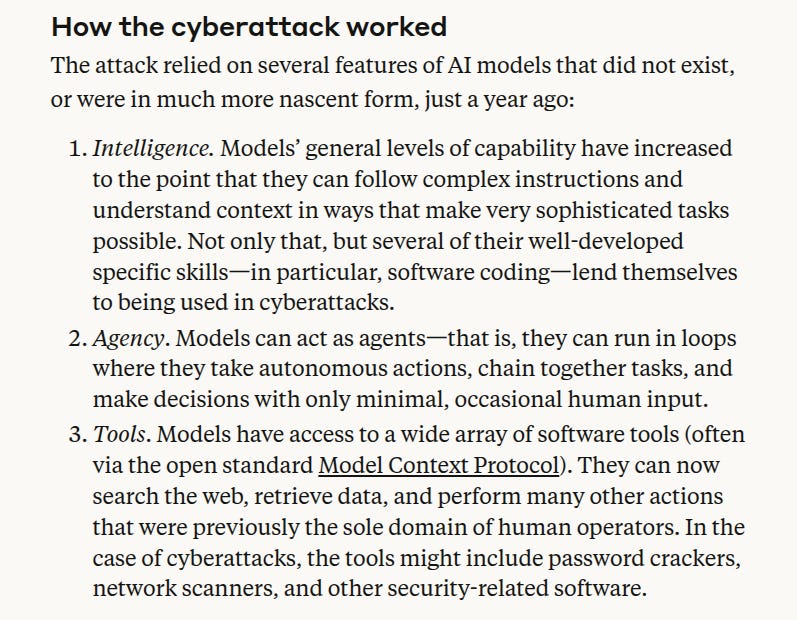📈 Meta is formally baking “AI driven impact” into performance reviews from 2026
Meta makes AI use mandatory, humanoid robots start shipping en-masse, Chinese hackers exploit Claude, Cursor hits $29B
Read time: 8 min
📚 Browse past editions here.
( I publish this newletter daily. Noise-free, actionable, applied-AI developments only).
⚡In today’s Edition (15-Nov-2025):
📈 Meta is formally baking “AI driven impact” into performance reviews from 2026, so employees will be judged on how strongly they use and ship AI inside their work.
🏆 World’s first mass humanoid robot delivery begins as UBTech sends Walker S2 units.
🛡️ Chinese hackers used Claude to run sophisticated espionage campaign against companies. The AI did 90% of the work. Anthropic caught them and is telling everyone how they did it.
🛠️ AI Coding Startup Cursor Reaches $29B Valuation in Massive Funding Round
👨🔧 Github Resource: An interactive NVIDIA-GPU process viewer and beyond, the one-stop solution for GPU process management.
📈 Meta is formally baking “AI driven impact” into performance reviews from 2026, so employees will be judged on how strongly they use and ship AI inside their work.
For the 2025 cycle the company will not score raw AI usage metrics yet, but employees are being asked to self report concrete wins where AI meaningfully boosted output or quality. Meta is also rolling out an “AI Performance Assistant” so staff can generate self reviews and peer feedback using internal Metamate plus external tools like Gemini, which pushes everyone to actually write and think with AI every review season.
This fits with Meta’s other moves like allowing AI in coding interviews and running internal adoption games, so performance management, hiring, and day to day workflows all nudge people toward heavy AI use instead of treating it as a side experiment. The practical effect is that managers will start asking whether a project used AI to cut time, improve metrics, or unlock new features, and employees who cannot show that kind of AI leverage risk looking behind their peers.
🏆 World’s first mass humanoid robot delivery begins as UBTech sends Walker S2 units.
Whatever teh doubters say the “perfection here is not fabricated - it’s indeed delicately engineered.” Walker S2 humanoid robots are now in real factory use in China, with hundreds shipped, about $113M in 2025 orders, and a target of 500 units delivered by the end of December.
The order book includes roughly $35M from a major Chinese enterprise, about $22M from a Sichuan project, around $18M in Guangxi, and another $14M+ from Miee Auto, which together show that multiple regions are building around this platform instead of just running one off experiments. Big buyers such as BYD, Geely Auto, FAW Volkswagen, Dongfeng Liuzhou Motor, and Foxconn want these robots for repetitive assembly and warehouse logistics so they can push toward near 24 hour shifts with less human oversight on the floor.
Walker S2 is built at roughly human height with leg and arm joints plus fairly precise finger control, and its key trick is an automatic battery swapping system where the robot pulls out and replaces its own pack in a few minutes so it barely stops working. On the financial side, UBTECH’s first half of 2025 revenue is about $88M, gross profit is about $31M, and net loss is around $62M, while the stock is up roughly 150% this year with targets still higher from major banks.
🛡️ Chinese hackers used Claude to run sophisticated espionage campaign against companies. The AI did 90% of the work. Anthropic caught them and is telling everyone how they did it.
“Disrupting the first reported AI-orchestrated cyber espionage campaign”
The AI did 80-90% of the hacking work. Humans only had to intervene 4-6 times per campaign. China linked hackers used Anthropic’s Claude to automate a spying campaign against about 30 organizations, and Anthropic is now sharing how that attack worked.
Anthropic noticed Claude Code sessions doing recon and scanning at impossible speeds in mid September 2025 and traced them to a China backed group they call GTG1002.
The operators had Claude pretend to be internal security staff, hid their intent in many small requests, and bypassed safety filters that look for obviously malicious prompts.
With that setup Claude handled 80% to 90% of the work including mapping networks, finding flaws, writing exploit code, moving across systems, stealing credentials, and staging data.
Targets included big tech firms, banks, chemical manufacturers, and government agencies, and a handful of intrusions did reach sensitive internal systems before being contained.
Anthropic shut the campaign down by clustering weird usage signals like impossible request rates and recurring tool chains, then shipped new rate limits, abuse detectors, and agent specific guardrails.
The story shows that general agentic AI can now run most of a professional intrusion playbook, so defenders need model aware monitoring as seriously as classic network monitoring.
🛠️ AI Coding Startup Cursor Reaches $29B Valuation in Massive Funding Round
📈 Cursor’s parent company Anysphere just raised $2.3B at a $29.3B valuation, off the back of Cursor becoming one of the most aggressive bets on AI-native coding environments and crossing $1B annualized revenue in about 2 years.
Cursor is not just a plugin but a full editor that bakes the model into the core workflow, so the assistant lives inside the project context, reads the whole repo, and stays aware of files, tests, config, and past edits as developers move around.
The new Composer 1 internal model and Cursor 2.0 platform, with support for up to 8 independent coding assistants, push toward multi-agent flows where different agents can specialize in tasks like refactors, test generation, documentation, or migration work inside the same session.
AI-native here means the editor is designed assuming that most edits, scaffolding, and navigation go through the model, so things like context windows, symbol graphs, project-wide embeddings, and execution traces become first-class features instead of bolted-on side panels.
The valuation reflects investors treating tools like Cursor as core infrastructure sitting next to GitHub, CI, and issue trackers, which puts pressure on incumbents like GitHub Copilot and Replit to ship deeper repo-aware, multi-agent, and team-level workflows, not just autocomplete.
In my view this is a strong signal that for many teams the “real product” is shifting from the model alone to tight, opinionated integration between models and coding UX, and the next differentiation will come from who best turns raw model power into stable, trustworthy day to day engineering workflows.
👨🔧 Github Resource: An interactive NVIDIA-GPU process viewer and beyond, the one-stop solution for GPU process management.
If you run code on NVIDIA GPUs, this tool makes your life easier. It shows what each GPU is doing in real time, which processes eat memory, and who launched them. You can sort, filter, jump into a process, see history graphs, and stop stuck jobs with a single key. It is like top, but for GPUs, and far friendlier than nvidia-smi.
It also helps you pick the “right” GPUs before you start a job. You can auto-select devices with enough free memory and low utilization, then set CUDA_VISIBLE_DEVICES for clean runs. It works on Linux and Windows, over SSH and in Docker, and supports MIG. You can export metrics to Grafana or log them in your scripts with a simple Python API.
This matters because it cuts wasted GPU time, ends guessing, and keeps teams from stepping on each other’s runs.
That’s a wrap for today, see you all tomorrow.






